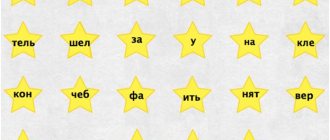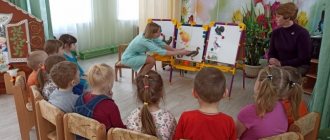Methodology for early detection of dyslexia according to A.N. Kornev
In 1982, a method for early detection of dyslexia according to A.N. was proposed. Kornev (MRVD), developed as part of a dissertation research for the degree of candidate of pedagogical sciences and recommended in the Letter of the Ministry of Health of the USSR. Based on a neuropsychological analysis of children with signs of dyslexia, a group of tasks has been developed that can differentiate manifestations of dyslexia from other forms of retardation, for example, mental retardation, pedagogical neglect. Diagnostics is aimed at children of senior preschool and primary school age (6-7 years). The purpose of the study is to detect signs of inferiority of obsessive operations in various modalities.
Methods for early detection of dyslexia
includes 4 types of tasks described in the books of the author of the method.
Row speaking
The child is asked to utter an automated speech sequence, naming the seasons in order. It is acceptable to offer a hint at the beginning of the task if the child confuses the seasons with months, parts of the day or days of the week. It is not knowledge itself that is assessed, but the ability to reproduce automated enumeration in order in the correct sequence. If errors occur, the child is asked to complete the task again to eliminate accidental errors. Then the child is asked to list the days of the week.
Each violation of automated pronunciation is assessed with “penalty” points as follows:
- correct answers to both questions - 0 points;
- correct answer to 1 question - 2 points;
- no correct answer - 3 points.
Direct and reverse repetition of numbers
The child is asked to repeat after the researcher several numbers in the same order. The numbers are called at a moderate pace, as when counting the starting time. Accelerating the tempo makes it easier to memorize and, accordingly, distorts the result. If you make a mistake, you are given the right to a second try. RAM must maintain the order of digits of a certain length.
The second task is to reversely reproduce the given order of numbers. An example is provided throughout the explanation to ensure a confident understanding of the assignment. The length of the order of digits in this case is less than in the first task.
It is necessary to gradually increase the length of the digital series in order to determine in both cases the length of the memorized series, reproduced in the forward and reverse directions. To evaluate, the length of both rows (that is, the number of memorized digits) is summed up.
The assessment is made as follows:
- more than 6 words – 0 points;
- 6 words – 2 points;
- less than 6 words – 3 points.
It should be noted that counting backwards better characterizes the amount of RAM, since the child must fix the direct digital series, sequentially inverting it.
Playing rhythms
The child is asked to reproduce four rhythmic patterns in sequence. First, simple rhythms are presented, and the right to repeat is given if a single mistake is made. Then two complex rhythms are presented while maintaining the criteria for completing the task.
At the same time, the ability of auditory discrimination of rhythms and auditory gnosis of rhythmic complexes are assessed. It is possible that the task may be distorted due to a defect in dynamic praxis, when the child makes an “extra” blow, which is explained by impaired motor skills.
The assessment is made as follows:
- 4 rhythmic rows are reproduced – 0 points;
- 2 rhythmic series are reproduced, consisting of no more than four beats each – 2 points;
- not a single rhythmic series is reproduced - 3 points.
"Fist-rib-palm"
The child is asked to carefully monitor the researcher’s actions and repeat them three times in the same sequence. You hit the table with your fist, place your palm on the edge and clap your palm on the table three times in a row, without pauses between series.
If there is a single error, the right to re-execute the task is granted. If obvious mistakes are made, the demonstration of the task is repeated. No more than five demonstrations are allowed.
This task is similar to the neuropsychological test "fist-rib-palm", but the movements are performed differently. Neuropsychological testing evaluates dynamic praxis, that is, the ability to switch from one movement to another. When diagnosing the risk of dyslexia, the ability to correctly reproduce a certain sequence is examined.
Assessment of task completion is carried out as follows:
- correct reproduction after one or two attempts after the 1st demonstration - 0 points;
- correct reproduction after 2 demonstrations or after 3 demonstrations on the 1st attempt - 2 points;
- correct reproduction after 4 and 5 demonstrations or after 3 demonstrations from the 2nd or 1 more attempts, lack of correct reproduction—3 points.
Final assessment of the Early Dyslexia Assessment
The final assessment according to the method of early detection of dyslexia is made by summing the results of the first, second and worst result when performing the third or fourth task (result with the maximum number of penalty points).
The total amount of penalty points consists of the results of the assessment of series speaking, repetition of number series and reproduction of rhythms or sequences of actions.
Final assessment of MRVD:
- up to 5 points inclusive – normal, there is no risk of developing dyslexia;
- more than 5 points – there is a risk of developing dyslexia. The more penalty points, the higher the risk of developing dyslexia.
Article:
The later disorders are discovered in children, such as a persistent inability to master reading and writing, the greater the severity they reach and the longer the corrective course in such cases is required.
The effectiveness of correctional work depends significantly on this. Based on the basic principles of simplicity and a minimum amount of time, A.N. Kornev. (1982) developed a technique for early detection of predisposition to dyslexia (EDD).
We use this technique (MRVD) during the initial speech therapy examination of children 6-8 years old. The MRVD examination does not require special equipment and takes about 5-8 minutes. The main task is to identify, during mass examinations, groups of children who are suspicious of the possibility of developing a particular disorder (the so-called “risk group”). These children exhibit symptom complexes that include 3-4 deficient functions, which is expressed in the inability to perform relevant tasks or the low quality of their performance. These symptom complexes are absent not only in healthy children, but also in children with other forms of mental retardation that do not make it difficult to master reading. Thus, the detection of symptom complexes before starting school can be regarded as reliable evidence of a high risk of dyslexic disorders in a given child. Tasks that reveal the inferiority of mental functions included in these symptom complexes are used as the basis of a screening methodology that includes the following tasks:
“Serial speaking” (listing the days of the week and seasons in direct order);
Instructions: “List in order the seasons and (after the answer) the days of the week” (if there is insufficient understanding, help in the form of leading questions or a hint that does not contain an ordinal listing is acceptable).
“Rhythms” (playing sound rhythms);
Instructions: “Listen to me knock, and after I finish, knock in the same way.” After this, a series of blows on the table (with a stick or pen) is presented once at long and short intervals:
1) simple rhythms - 1! !, !!!,!!!!,!!!!,!!!!; if the task is completed correctly, then move on to a more complex one; if more than one mistake is made, then stop;
2) complex rhythms - !!!!!,!!! II,!!!!!. II!!!!. The criterion for fulfillment is the same as in simple rhythms.
Test “Fist-rib-palm”;
Instructions: “Look carefully at what I’m going to do now, and repeat it exactly the same way.” The experimenter demonstrates to the child a sequence of three hand movements three times: hit the table with the fist, place the palm on the edge, slam the palm on the table. The child, like the experimenter, must reproduce this sequence three times without errors. If the child violated the sequence of movements no more than once, it is necessary to indicate that a mistake was made and give him another try (if the child reproduced a sequence of 3 movements only once and after stimulation continued it correctly, then this is not considered an error). If the reproduction is obviously erroneous, the sample demonstration is repeated. A maximum of 5 demonstrations are allowed.
Subtest “Repetition of numbers”;
Instructions: “Now I’ll tell you a few numbers, and you, as soon as I finish speaking, repeat them in exactly the same order.” Attention! After this, the experimenter, in an even voice, without changing intonation on the last digit, in the rhythm of the start time countdown, calls a row of three digits (see digital rows). In case of incorrect reproduction, another row of three digits is presented. If played correctly, they move on to a row of 4 digits and so on up to a row of 5 digits. The experimenter records the number of digits in the largest correctly reproduced row. This is a preliminary assessment for the first half of the assignment. After this, a new instruction is given: “Now I will tell you a few more numbers, and you will also repeat them, but just start from the end and repeat them in reverse order. For example: if I say 3-4, then you should say 4-3.” In this case, for clarity, you need to alternately touch two imaginary points on the table with your finger: first from left to right, then from right to left. The tactics for examining and recording the results are the same as in the first half of the task: first a series of 2 numbers is offered, then 3, etc. The final result of completing the entire task is the sum of preliminary marks for the first and second halves of the task.
DIGITAL SERIES
Direct count:
№ 3 7-3-1 8-6-5
№ 4 4-1-6-9 3-8-7-5
№ 5 7-8-4-2-3 2-5-9-1-8
Countdown:
№ 2 1-8 6-4
№ 3 9-3-1 8-6-4
№ 4 6-7-9-2 8-1-3-5
Orientation in terms of “right-left”;
1. Simple orientation. Instructions: “Raise your left hand (be sure to start with the left), show your left leg, right eye.” If the task is completed, then move on to the next one; if not, stop.
2. Head's speech test. Instructions: “Grip your right ear with your left hand, your right ear with your right hand, your left ear with your right hand, show your right eye with your left hand.”
Making up stories based on a series of pictures.
The child is presented with a story in 2 pictures (the story about a hen, chickens and a samovar pipe from N. Radlov’s book “Stories in Pictures” is convenient for use). In the story, the first picture shows: a hen that has taken 4 yellow chickens for a walk, and a samovar pipe lying on the ground, into which one of the chickens is looking. In the second picture, the surprised hen, looking back, sees that three chickens have crawled out of the chimney black, and the fourth, still yellow, chicken is looking into it.
Instructions: “Look! These pictures contain a short story. Tell me: what is drawn here? Make up a story based on these pictures.”
If the child cannot compose a story on his own or lists the depicted objects instead, then you need to ask leading questions. After the child has finished the story, the question is asked: “Explain: why did the chickens turn black?”
When examining children 6.5-7.5 years old without severe speech pathology, the following three scores are summed up: for “Series Speaking”, “Repetition of Numbers”, “Rhythms”. A score greater than 5 indicates a predisposition to dyslexia.
As an example, data from a survey of first-graders in one of the city schools is given.
| № | Test name | Number of children who failed the test, % 2013-2014 | Number of children who failed the test, % 2014-2015 |
| 1 | Row speaking | 25% | 28% |
| 2 | Rhythms | 27% | 22% |
| 3 | “Fist-rib-palm” | 20% | 24% |
| 4 | Repeating numbers | 37% | 25% |
| 5 | Orientation “right-left” | 31% | 31% |
| 6 | Compiling a story based on a series of pictures | 68% | 54% |
In general, according to the results of the survey in the 2013-2014 school year. year, 20 “at-risk” children were identified, which is 37% of the total number of first-graders.
In the 2014-2015 academic year. year, 16 “at-risk” people were identified, which amounted to 24% of the total number of first-graders.
Thus, examination using MRVD is only the first stage in identifying pathology. A selected group of children at increased risk undergo a series of psychological, pedagogical and speech therapy measures aimed at preventing dyslexic disorders.
Literature.
- Kornev A.N. On the age-related dynamics of dyslexia in children and the prognosis of its compensation. L. 1986
- Kornev A.N. Neuropsychological research methods, St. Petersburg, 1991.
- Kornev A.N. Reading and writing disorders in children. St. Petersburg, 2003
Other methods for assessing the risk of developing dyslexia in preschoolers
Consider a battery of risk tests implemented in other language settings as predictors of dyslexia. Partially, these tests can be used starting from 5 years of age, which distinguishes them favorably from the domestic methodology discussed above.
Rapid Serial Naming Test
The test was developed by an international group of experts and tested for different age groups. Beforehand, a training task is performed, during which the researcher must make sure that the child knows the necessary names. The normal execution time for each task is 1 minute.
Serial image naming
The child is offered stimulus material with a set of repeating pictures (36 images). The task consists of quickly naming the depicted objects out loud. Errors made and execution speed are taken into account.
Serial color naming
The child is offered stimulus material with a set of repeating colors, which he must name as quickly as possible.
Serial letter naming
The child is offered stimulus material with a set of repeated letters, which he must name as quickly as possible.
Psychology of the development of written speech
Russian writing is initially based on a number of essential principles. The main ones are the following:
- phonetic (a letter symbol corresponds to a strictly defined phoneme that is used in oral speech);
- morphological (stability of morphemes with the help of which a word is formed, a fairly stable element);
- traditional (the historical preservation of the word model is observed).
Writing Skill
The skill of writing has a close connection with oral speech, but at the same time it also has independent psychophysiological foundations that make it possible to directly realize the ability to write. The writing process itself consists of 3 sequential operations:
- symbolic designation of sound units;
- modeling the phonetic structure of a word using graphic signs;
- grapho-motor operations presented in the diagram below.
Functional structure of writing mechanisms
Reading process
Reading as a way of activity is:
1) the complex process of decoding the graphic (sign) model of a word into an oral language type;
2) an equally complex process of perceiving and understanding the meaning of written messages.
A.N. Kornev proposed an innovative model for the formation of the decoding operation, i.e., creating the phonetic appearance of a word using graphic modeling. The main importance here is played by the skill of syllable fusion. Thus, the reading process is:
- recognition of a letter symbol in its connection with sound;
- combining letters into a syllable (syllable merger);
- combining syllables into a word;
- integration of words into a complete semantic phrase.
The study of reading pathology allows specialists to conclude that the leading symptoms at the initial stage of learning to read (grades 1-2) are:
- the persistent problematic nature of the formation of sound-letter relationships;
- a complete lack of ability to formulate syllables or its significant impairment.
Overcoming a defect
Corrective measures are developed individually and depend on the student’s level of written language proficiency.
Work is being carried out to consolidate sound-letter connections, to form and consolidate the skill of syllable merging, and to develop verbal and logical perception of a test message. Particular attention is paid to correct sound pronunciation, the development of phonemic analysis and synthesis, spatial analytical activity and the development of intelligence.
The selection of specific correction methods depends on the form of dysgraphia and dyslexia.
(Based on the book by A. N. Kornev, Reading and Writing Disorders in Children)










